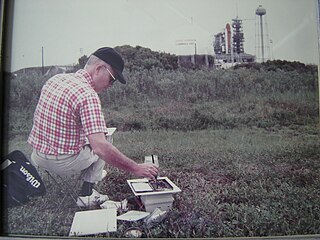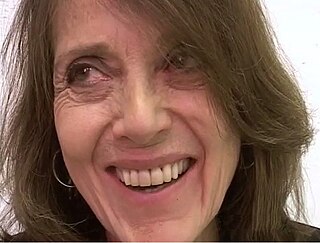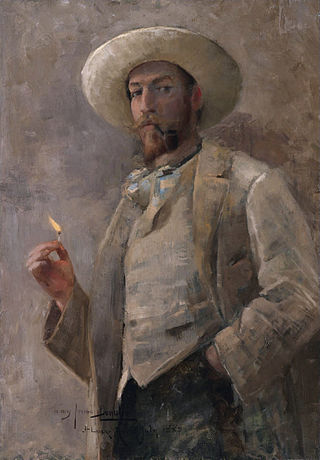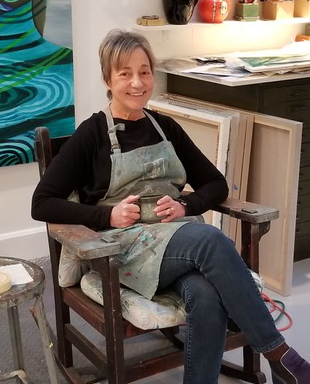Related Research Articles
John Walker is an English painter and printmaker. He has been called "one of the standout abstract painters of the last 50 years."
The New York School was an informal group of American poets, painters, dancers, and musicians active in the 1950s and 1960s in New York City. They often drew inspiration from surrealism and the contemporary avant-garde art movements, in particular action painting, abstract expressionism, jazz, improvisational theater, experimental music, and the interaction of friends in the New York City art world's vanguard circle.

Frederick Childe Hassam was an American Impressionist painter, noted for his urban and coastal scenes. Along with Mary Cassatt and John Henry Twachtman, Hassam was instrumental in promulgating Impressionism to American collectors, dealers, and museums. He produced over 3,000 paintings, oils, watercolors, etchings, and lithographs over the course of his career, and was an influential American artist of the early 20th century.
Katherine Porter was an American visual artist. Porter is considered one of the most important contemporary artists associated with Maine. She resisted categorization. Through the medium of painting and drawing her canvases convey the conflict inherent in life. She expressed her ideas with a visual vocabulary that was "geometric and gestural, abstract and figurative, decorative and raw, lyric and muscular."

Philip Jamison was an American artist working primarily with watercolor as a medium. Typical scenes are landscapes, seascapes, interiors and flower arrangements.

Pat Lipsky is an American painter associated with Lyrical Abstraction and Color Field Painting.
Julie Heffernan is an American painter whose work has been described by the writer Rebecca Solnit as "a new kind of history painting" and by The New Yorker as "ironic rococo surrealism with a social-satirical twist". Heffernan has been a Professor of Fine Arts at Montclair State University in Upper Montclair, New Jersey since 1997. She lives in New York, New York.
Włodzimierz Książek was a Polish-born contemporary artist based in New England, and since 2001 worked from a 6000 sq. ft. studio in Rhode Island. He was best known for his large-scale abstract paintings.

John Nelson Shanks was an American artist and painter. His best known works include his portrait of Diana, Princess of Wales, first shown at Hirschl & Adler Gallery in New York City, April 24 to June 28, 1996, and the portrait of president Bill Clinton for the National Portrait Gallery.

John Moore is an American contemporary realist painter. His art has focused on studio interiors, still lifes, and in his best-known work, cityscapes and the American post-industrial landscape of dilapidated mill towns and factories. He emerged in the early 1970s amid a resurgence of representational work, appearing in many surveys and critical examinations that helped define new modes of American realism. While the highly detailed nature of his work evokes that movement, it diverges from approaches such as photorealism in its social concern, painterly handling and composite compositions, which distill direct observation, sketches, memories and photographs of multiple sites and views into re-imagined but believable scenes. Curator John Stomberg wrote of these constructed worlds: "The image he creates is only real in the painting, yet all the parts do have their origins in the observable world. Therein lies the eerie potency of Moore's vision—its plausibility. He is more of a spectacular fabulist than a realist."

Gaines Ruger Donoho was an American painter.
Aaron Fink is an artist working in a variety of mediums including oil, prints, sculpture and works on paper.
Gregory Amenoff is an American painter. He is located in the tradition of the early American Modernist painters Georgia O'Keeffe, Charles Burchfield, Milton Avery, Arthur Dove and Marsden Hartley. In the early 80s his work was often associated with a style of painting called organic abstraction and exhibited alongside artists Bill Jensen, Katherine Porter and Terry Winters.

Joseph Irwin Zucker was an American artist. Born in Chicago, he received a B.F.A. from the Art Institute of Chicago in 1964 and an M.F.A., from the same institution in 1966.

Bernard Childs (1910–1985) was an artist who worked in Paris and New York. He was primarily a painter and printmaker, and pioneered the direct engraving of metal plates with power tools. As a kind of counterpoint to his many-layered work, which is often symbolic and a fusion of abstraction and figuration, in 1959 he also started painting portraits. Childs' formal interests were line and space, light and color, and the dialogue of contrasting elements.
Robert Feintuch is an American painter who lives and works in New York City.

Terrell James is an American artist who makes abstract paintings, prints and sculptures. She is best known for large scale work with paint on stretched fabric, and for parallel small scale explorations such as the Field Studies series, ongoing since 1997. She lives and works in Houston, Texas.

Jake Berthot (1939–2014) was an American artist whose abstract paintings contained elements of both the minimalist and expressionist styles. During the first 36 years of his career his paintings were entirely non-figurative. His style changed in 1995 when he moved his studio from New York City to a rural community in upstate New York. While continuing to be abstract his paintings thereafter contained figurative elements and were seen to have greater emotional content. Throughout his career his work frequently appeared in solo and group exhibitions in both commercial and public galleries. It has been collected by the Museum of Modern Art, Metropolitan Museum of Art, Guggenheim Museum, National Gallery of Art, and other major American art museums. He received a Guggenheim Fellowship in 1981 and a National Endowment for the Arts grant in 1983.

Barbara Grad is an American artist and educator, known for abstract, fractured landscape paintings, which combine organic and geometric forms, colliding planes and patterns, and multiple perspectives. Her work's themes include the instability of experience, the ephemerality of nature, and the complexity of navigating cultural environments in flux. While best known as a painter, Grad also produces drawings, prints, mixed-media works and artist books. She has exhibited in venues including the Art Institute of Chicago, Kemper Museum of Contemporary Art, Danforth Art, Rose Art Museum, Indianapolis Museum of Art and A.I.R., and been reviewed in publications, including Artforum, Arts Magazine and ARTnews. Grad co-founded Artemisia Gallery, one the country's first women-artist collectives, in Chicago in 1973. She has been an educator for over four decades, most notably at the Massachusetts College of Art and Design. Grad has been based in the Boston area since 1987.

John Dilg is an American painter based in the Midwest. He is known for idiosyncratic landscapes that use a pared-down visual vocabulary drawing on imagination, vernacular artifacts, folk art and art historical sources. Critics describe them as dreamlike ruminations on place, the fragility of nature, the collective unconscious and mystical storytelling. Precedents for his work that have been cited include 19th-century Romantic landscape painters, Marsden Hartley, Georgia O’Keeffe and Horace Pippin, and the imaginary vistas of Henri Rousseau.
References
- 1 2 "Faculty: John Lees". National Academy Museum and School. Archived from the original on April 1, 2012.
- ↑ Cathcart, Linda L. American still life, 1945–1983, Contemporary Arts Museum Houston, 1983. ISBN 0-06-430131-1. Accessed September 19, 2011. "John Lees: Born in Denville, New Jersey, in 1943, he received his B.F.A. and M.F.A. from Otis Art Institute, Los Angeles in 1967."
- 1 2 3 4 5 6 "John Lees" (PDF). Betty Cunningham Gallery. Archived from the original (PDF) on April 2, 2012.
- ↑ "New York Is A Gallery of the Best by Living Artists". The New York Times. February 18, 1983.
- ↑ John Lees (1989). John Lees, paintings & drawings: Hirschl & Adler Modern, December 7 – January 6, 1989: October 17 – November 17, 1989, the Mayor Gallery. Hirschl & Adler Modern.
- ↑ Mary Sherman (April 14, 1989). "Goldberg and Lees challenge tradition". Chicago Sun-Times. Archived from the original on November 6, 2012.
- ↑ "Artist John Lees enters a new phase". Boston Herald . April 19, 1992. Archived from the original on November 7, 2012.
- ↑ Cate McQuaid (May 15, 1997). "Sublimely Sinister John Lees". Boston Globe.
- ↑ Cate McQuaid (April 1, 2005). "A Mix of the Sacred and Profane, Revealed in Layers". Boston Globe . Archived from the original on November 7, 2012.
- ↑ Holland Cotter (March 15, 1996). "Art in Review". The New York Times.
- ↑ Benjamin Genocchio (May 13, 2007). "Obsessive Compulsions". The New York Times .
- ↑ Michele Willens (January 1, 1987). "Lessons of a judicious couple who won big collecting art". MONEY Magazine.
- ↑ Cate McQuaid (March 7, 2003). "At Nielsen, A Stirring Show That Layers Time and Paint". Boston Globe. Archived from the original on November 7, 2012.
- ↑ "John Lees Exhibition". Betty Cunningham Gallery. March–April 2008. Archived from the original on April 2, 2012.
- ↑ "Works on Paper: John Lees/Gordon Moore". Betty Cunningham Gallery. May–June 2009. Archived from the original on April 2, 2012.
- ↑ "John Lees Exhibition". Betty Cunningham Gallery. April–May 2011. Archived from the original on April 2, 2012.
- ↑ David Cohen (March 13, 2008). "Deliciously Distressed". New York Sun .
- ↑ "Hassam, Speicher, Betts, and Symons Purchase Fund". American Academy of Arts and Letters.
- ↑ "John Lees (American, born 1943)". Museum of Modern Art.
- ↑ "John Lees American (Denville NJ born 1943) Black Mountain, 1993". Harvard Art Museums.
- ↑ "John Lees Selected Biography". Riverhouse Editions. Archived from the original on April 2, 2012.